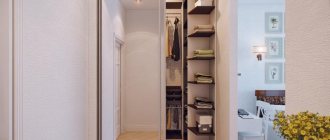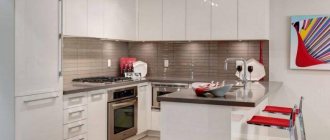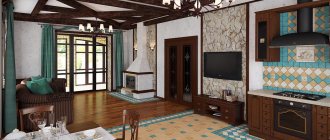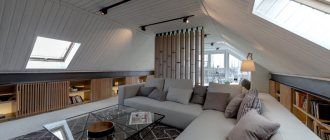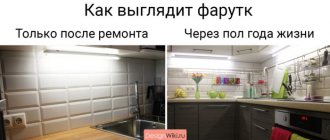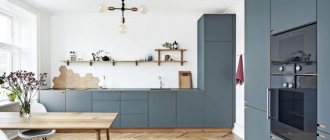The small dimensions of the kitchen force us to select compact options for its arrangement, which can be placed in one of the furnishings. Such options, which allow you to significantly save useful meters and centimeters, include a built-in hood. It takes up minimal space and does not affect the interior.
You can handle the installation of built-in exhaust hoods with your own hands if you know all the rules and subtleties of the work. We will tell you how to choose a unit for extracting exhaust air in the kitchen, and we will tell you how to install your purchase correctly.
What types are there?
Kitchen hoods can be divided into categories depending on different parameters.
Air recycling:
- Flow-through. It connects directly to the ventilation and discharges air into a special channel. Some models can also suck in fresh air, releasing it into the room. The disadvantage of such a hood is the presence of a pipe that will have to be hidden or disguised.
- Circulation. It sucks in polluted air, purifies it using carbon filters, and releases it back into the kitchen. Compared to flow-through, it is less effective and more demanding. Filters will have to be constantly changed and cleaned. However, it does not require connection to a ventilation shaft, so there is no problem with the air duct.
Control method:
- Mechanical. The simplest hood with a regular button panel. Found mainly in the budget segment.
- Slider. Instead of buttons there are sliders. They regulate power, lighting, and air flow direction. Reliable, found in a variety of designs.
- Sensory. The modern control method is often supplemented by a remote control, therefore it is considered as convenient as possible. Another plus is the possibility of easy cleaning due to the smoothness of the surface. They cost more than mechanics and sliders.
Material:
- Plastic. Cheap, easy to care for, but not durable.
- Enameled. They cost more than plastic, but last longer. They look aesthetically pleasing and are easy to care for.
- Steel. Stainless steel is lightweight and durable. It has one drawback - fingerprints constantly remain on the surface.
- Glass. Stylish, easy to care for, durable. Give preference to white tempered glass if you do not want to constantly wash dark matte glass from stains and smudges.
Classification by design
Structurally, kitchen hoods are divided into 3 types:
- Traditional. A classic kitchen hood is cheaper and simpler than others. These are standard models that are hung on the wall above the hob. There are both circulating and flow-through ones. The downside is that it requires a separate place, so you have to build a box to hide it.
- Built-in. The most inconspicuous option, mounted in a hanging module above the stove. Most often, such hoods are telescopic - that is, they have a retractable panel, due to which the coverage surface is increased. Hoods are built not only above the stove, but also into the countertop behind the stove - during cooking, it pulls out and remains open, and when not needed, it simply hides in the table.
The photo shows a system built into the countertop
- Dome. It is considered the most effective among the others because it captures the maximum amount of odors. In some cases, it has not only the top part, but also side shutters that do not allow dirt to escape.
The photo shows a white modern hood in the kitchen with brown facades
Varieties by shape
There are 6 main options for kitchen hoods:
- Flat. It is somewhat similar to a built-in one, but is an independent element. Thanks to its flattened geometry, it will save space in the kitchen.
- Dome. We already mentioned it in the last section. The dome shape literally hangs over the cooking area and absorbs all contaminants.
- T-shaped. With a panel between the pipe and the hood system itself, it is convenient to store spices, cooking accessories, and decor.
The photo shows a variant of a stylish, inconspicuous model
- Inclined. Perhaps it has the most eye-catching design - it is located at an angle relative to the hob. The main advantage of the solution is space saving and ease of access to the stove.
- Ostrovnaya. Most often it looks like a pipe in the form of a cylinder or parallelepiped hanging from the ceiling. Installed in any desired location.
- Corner. Ideal if the hob is located in a corner. Most often, the surface can be used for storage.
Carbon filter
The basis of such components is activated carbon. Thanks to its absorption properties, the air in the kitchen is perfectly cleaned!
Of course, they can handle fats and oils. But still, their main task is to neutralize various odors in the kitchen that appear during the cooking process (and especially frying or boiling). Thanks to the presence of a carbon filter, the hood reduces its productive power by approximately 1/5. Accordingly, the longer such a filter is installed, the worse the air will circulate. For this reason, the “validity” of such a filter is approximately 3–4 months. However, each manufacturer of such accessories makes its own recommendations regarding the period of operation.
Immediately after you have finished the cooking process, do not turn off the hood if you have a carbon filter installed. Let her work for a few more minutes. This will allow all the excess moisture to escape from the filter, making it last longer!
Recommendations for placement
To increase the efficiency of the hood, you must firstly choose it correctly, and secondly, install it correctly. Regardless of the shape, choose one that is wider than the width of the slab. This is the key to clean air. The depth, on the contrary, should be a little less - otherwise you will constantly hit your head on it.
Many people believe that the hood should be located directly above the apron - that is, at a height of 60 cm. But this belief is incorrect. The height of the location varies depending on the type of slab:
- 65-75 over electric;
- 75-85 over gas.
The exception is the inclined form. It is placed 45-55 cm above the electric stove and 55-65 cm above the gas stove.
Reducing the distance helps to better purify the air, but due to too small a space there is a high risk of damage to the system due to overheating.
The photo shows the repetition of clear geometric lines in technology and furniture
What to do if there is not enough power
The logical step is to replace the device with a more productive one. If this is not possible, you can remove the existing filters, especially the duplicate carbon ones. This will add up to 5% of the power from the nominal parameters, but will significantly increase noise.
You can install the hood yourself with a minimum set of tools.
Increasing power by partially replacing controls or the electric motor is recommended only after the official warranty for the product has expired. Such work is carried out by workshops that repair household appliances. Changing the layout of the technical part does not entail requirements for changing the air outlet communications.
How to hide a hood?
If you purchased the wrong model or changed the interior after installing the hood, you can hide it in a box. The advantage of this method is that there will be space above it for storing kitchen utensils.
An unusual but effective option is mirror film. Thanks to the visual illusion, everything unnecessary literally dissolves into space.
The photo shows the hood hidden in the box
However, most often it is not the exhaust system itself that needs to be closed, but the pipe from it. There are 4 main ways to do this:
- Hide in the ceiling. A suspended or suspended ceiling structure allows you to completely hide unsightly communications. But it will have to be placed at a lower level, because standard pipes have a diameter of 10-15 cm.
- Sew it into a box. Decorative boxes are made from chipboard, MDF, wood, metal, and plasterboard. This is a low-complexity job, so you can do it yourself. The disadvantage of this method is the lack of additional functionality.
- Place the closet in the top row. An additional second row of wall cabinets allows you not only to increase the storage area, but also to hide the corrugation leading to the ventilation.
- Decorate in the color of the walls. The method is suitable exclusively for monochromatic finishing. When you repaint the round pipe to match the color of the wall behind it, it will simply disappear.
If you are not bothered by the fact that there is a pipe in the interior and it suits the style of the kitchen (loft, modern, high-tech), leave it as is. Or make an accent on it by painting it in any bright color.
The photo shows the use of an illusion with mirror film
Installation of the device
With some skills, you can install the hood yourself. But it’s better to invite a specialist. First, measure the dimensions. Then take measurements from the cabinet. If it is of the same dimensions, the device is mounted in it. When the hood is larger than the cabinet, it is installed using a box. Installing a built-in hood is not a very complicated process, but it is labor-intensive.
A hole of the required size is cut in the furniture. The top of the cabinet is modified to suit the desired shape. It is necessary to make a hole for the air duct, which should connect the outlet of the device and go to the ventilation window in the wall.
Usually a rectangular plastic ventilation duct is inserted. Therefore, it is necessary to cut a rectangular hole in the upper compartment of the furniture.
The back of the hood is mounted to the wall, which requires making another cutout in the cabinet. Since there must be some mobility, the device is secured with a clamp. The panel must be left movable. When cleaning, all parts will have to be removed.
Interior design ideas
A hood in the kitchen interior will become a harmonious addition to the design if you choose the right model.
In a country or Provence style kitchen, the central element will be a large domed hood with a carved side. To make it even more noticeable, choose a contrasting color option.
A domed hood with gold trim will harmoniously fit into a classic interior. An alternative idea for a classic style is any hood hidden behind wooden sides under the facades.
The photo shows a spacious kitchen with steel appliances
When decorating a modern kitchen in the Art Nouveau style, pay attention to sloping glass options or modern island models.
A designer inclined hood made of tempered glass or a steel domed one is also suitable for the high-tech trend.
The photo shows an interior in a minimalist style
Depending on the environment, steel or black hoods are purchased for the loft. The shape is suitable for dome, cylindrical, rectangular.
The photo shows a variant of a non-standard kitchen design in the house
Fully built-in
These hoods are great for small spaces. They do not occupy a large area, they are not visible from under the cabinet or countertop.
With an active filter, recirculation is activated when purified air is returned to the room. In this case, there is no need to make a special exit from the room to remove exhaust air.
Examples for small kitchens
The main task in a compact kitchen is to save space. The hood must also meet this parameter. The most laconic models are built-in or flat. Moreover, if they are circulation, there will be no need to place a bulky pipe.
For all their advantages, models built into a closet or placed under it are not the most economical. There are more invisible, but no less effective technologies.
Embedding it in the ceiling will solve the problem of saving space in cabinets. If you place the hood inside a tension or hanging frame, it can go completely unnoticed - only the decorative grille will be visible from the outside.
In a private house it is possible to place ventilation equipment in the wall. Remaining practically invisible, it copes with its functions perfectly.
When it’s too late to make changes to the design or finishing, installing a model built into the countertop helps out. The hood is located in close proximity to the cooking area and efficiently draws in polluted air. And getting to it for cleaning grease or replacing filters is much easier.
The photo shows the placement of appliances in a small kitchen
Classification
Built-in hoods are divided into:
- Fully built-in.
- With retractable panel.
- Visors.
Devices with retractable and visor panels draw in more polluted air because they are larger. They are usually equipped with one or two motors. But at high power a large amount of noise is produced.
Functional capabilities
A kitchen set with an inclined type hood has an unusual and elegant appearance. This is facilitated by high-quality and economical LED lighting, ergonomic shape, as well as the capabilities of the device. The functionality of the equipment is an important factor when choosing, and various models, in addition to convenient touch control, demonstrate the following capabilities:
- Automation of the start of work: automatic switching on and off, delayed start, timer.
Compact location Source onliner.by
- Special software monitors the condition of the filters and signals the need to replace them.
In a country kitchen Source homevalley.ru
